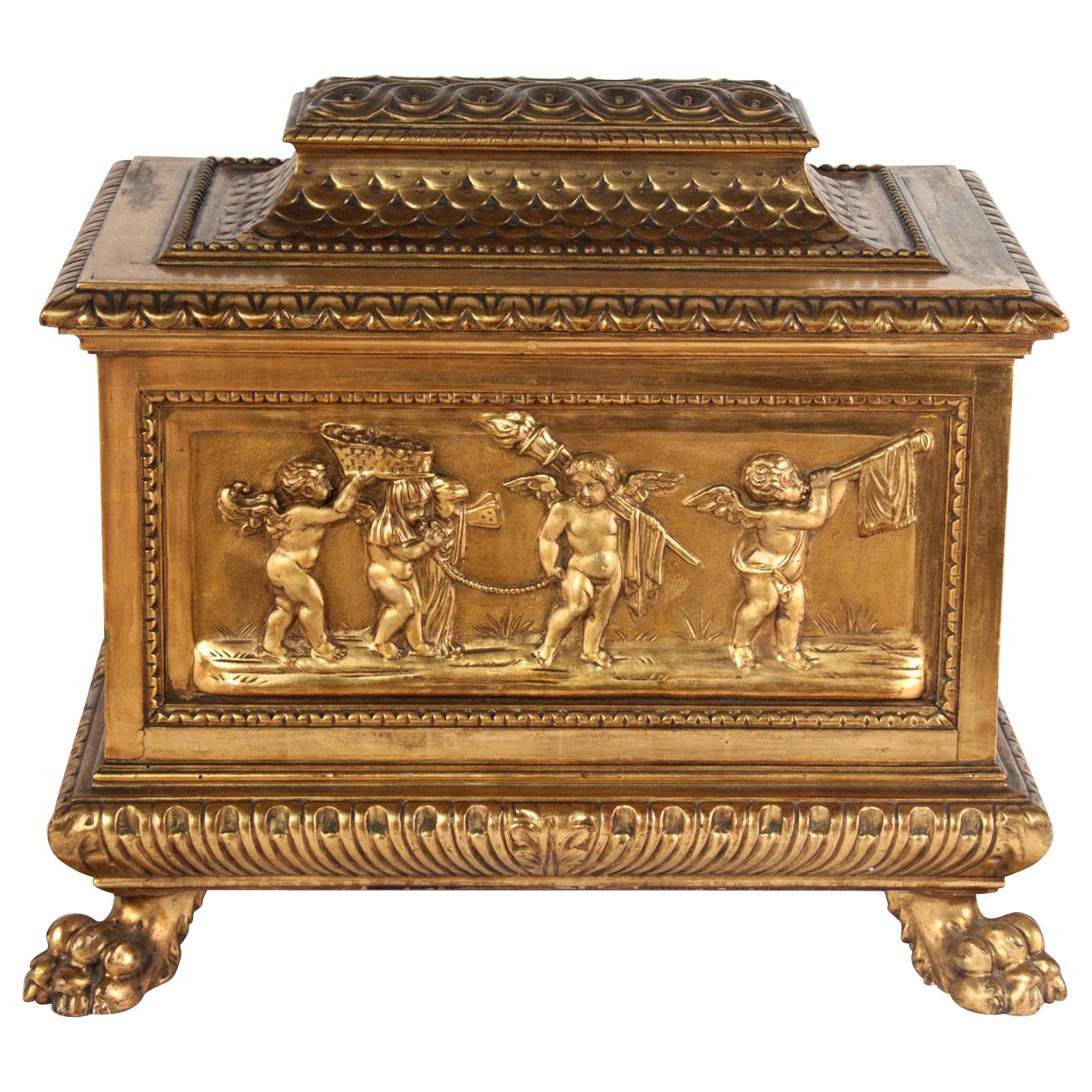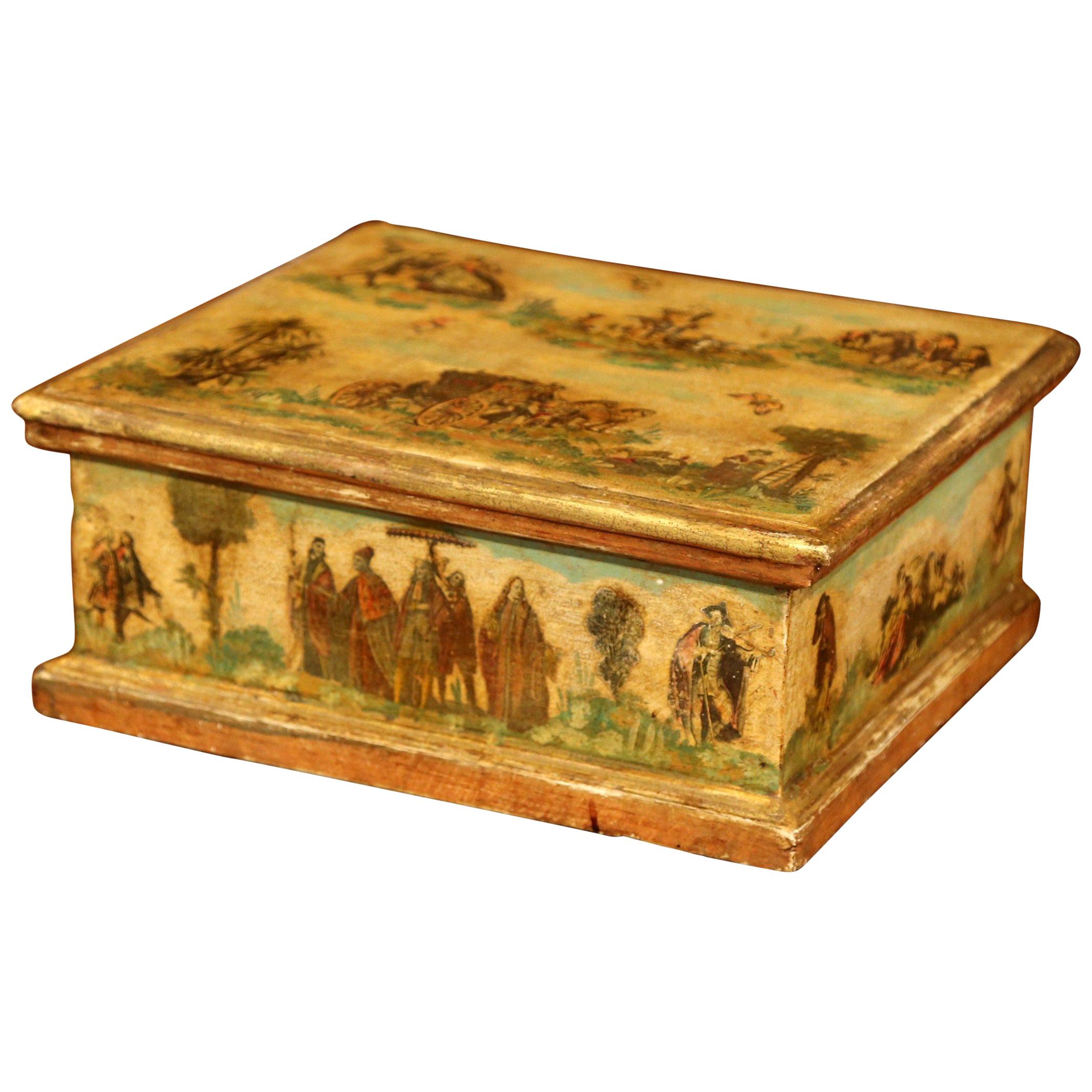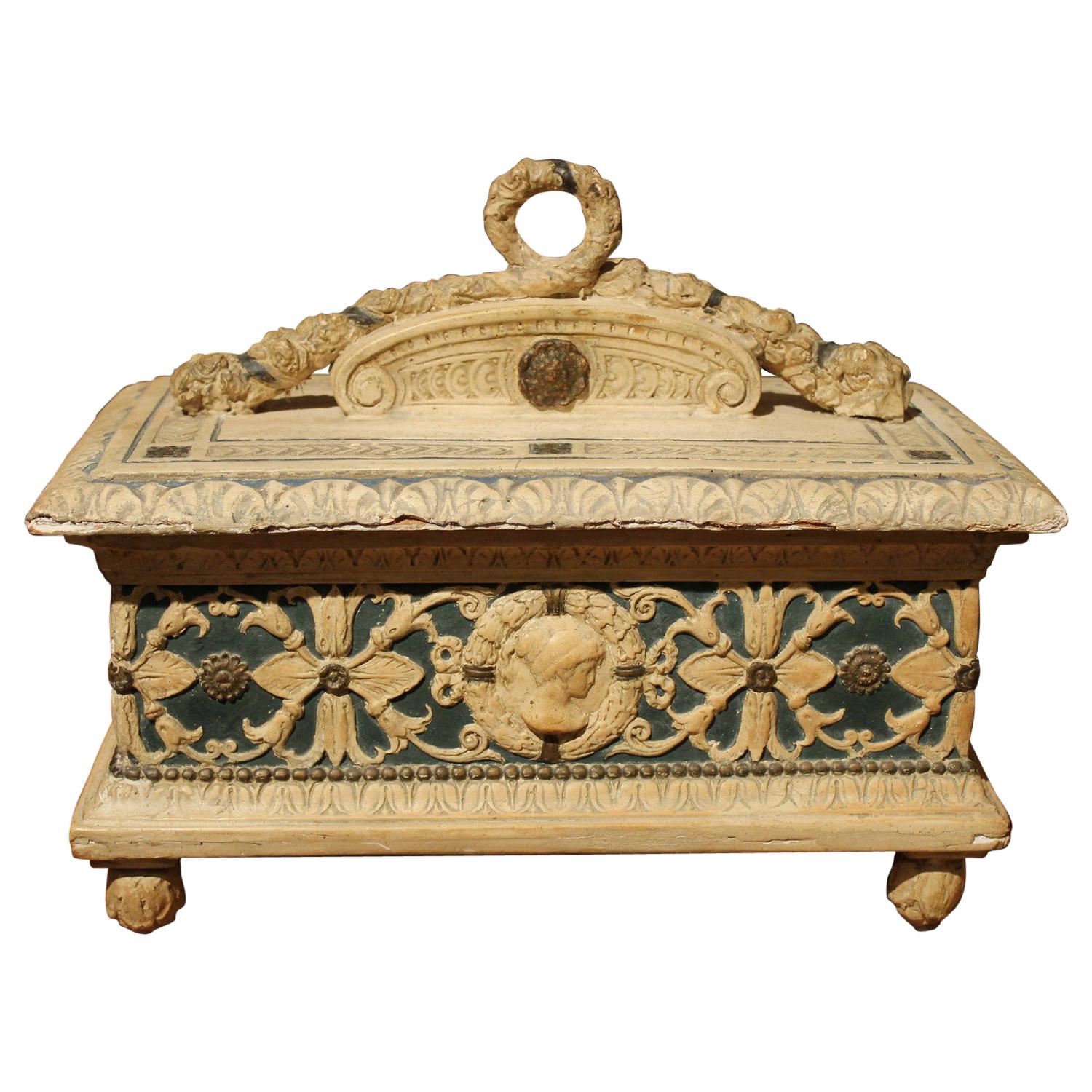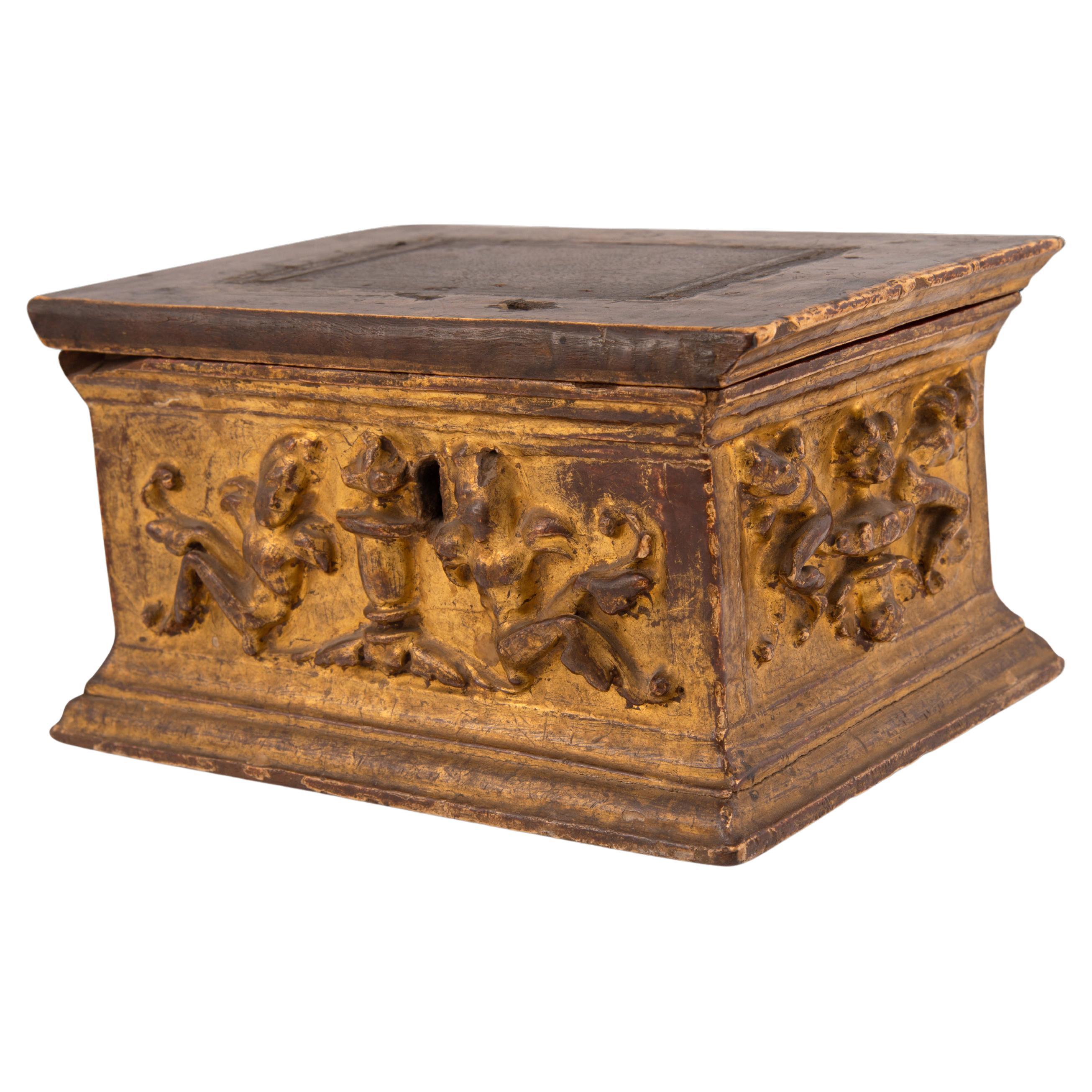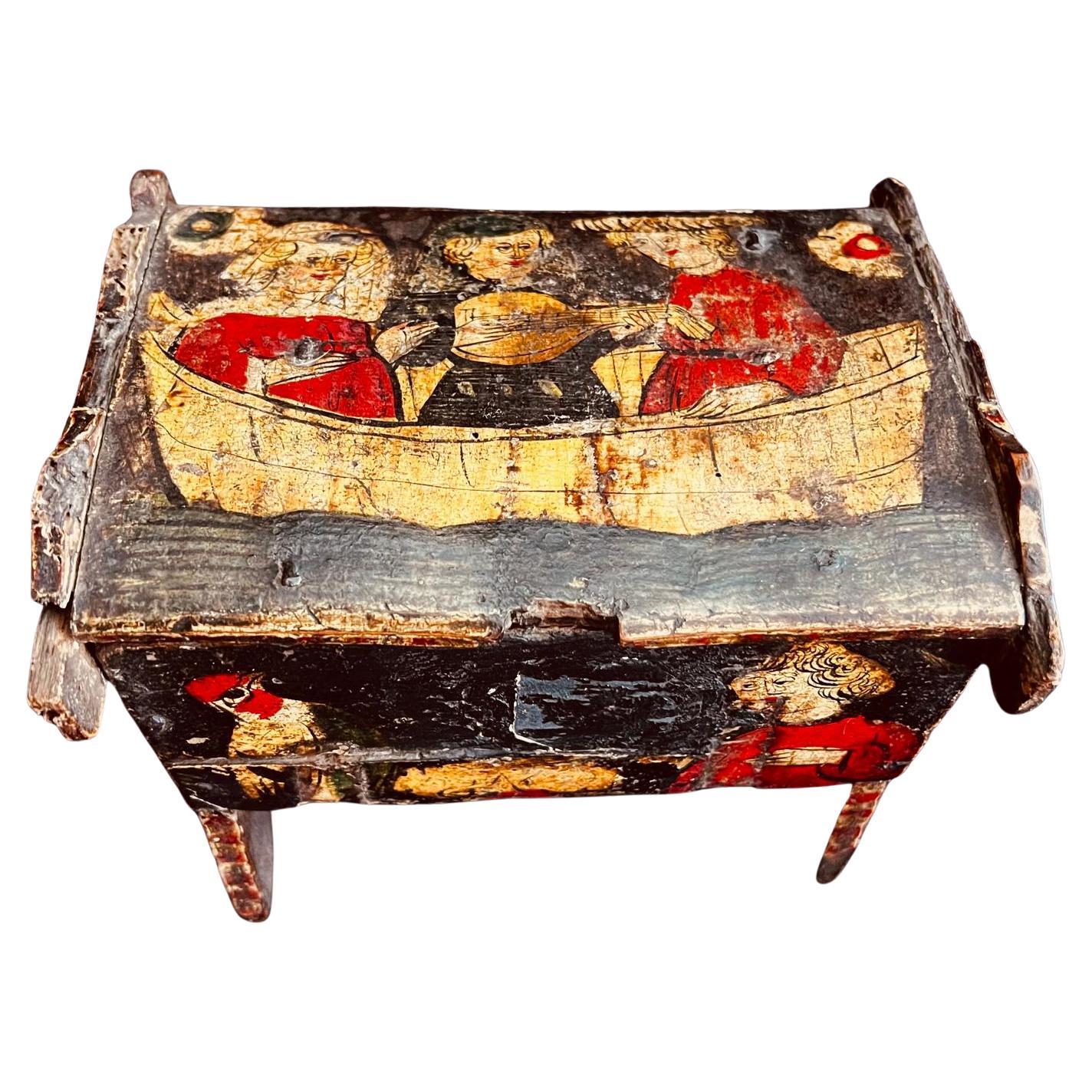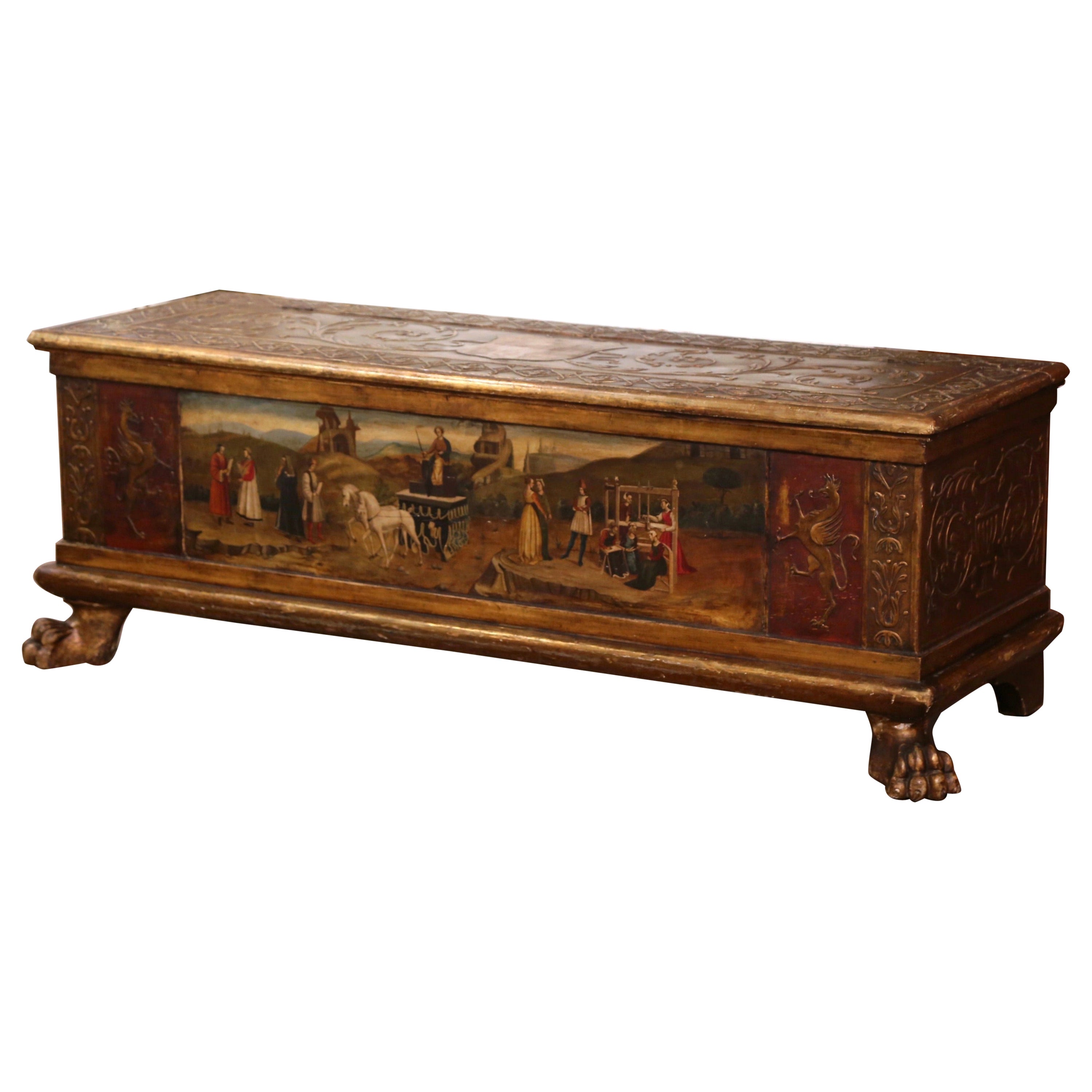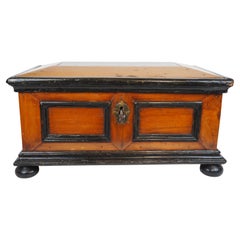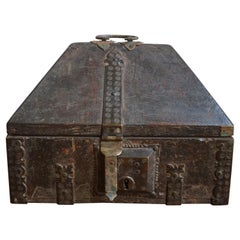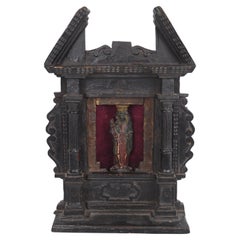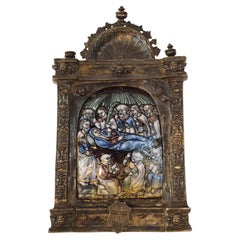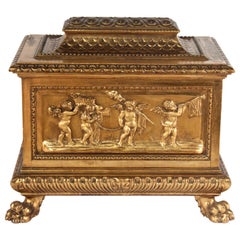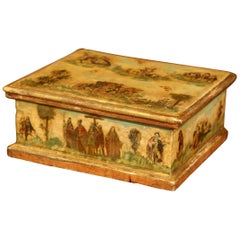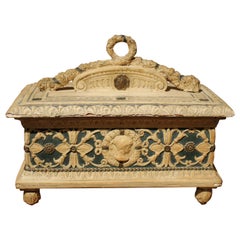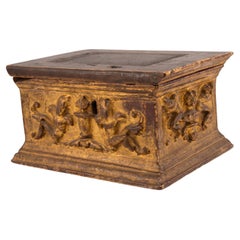Items Similar to Wooden casket with polychrome and gilded "pastiglia" relief decor, Italy 15th c.
Want more images or videos?
Request additional images or videos from the seller
1 of 21
Wooden casket with polychrome and gilded "pastiglia" relief decor, Italy 15th c.
$14,818.86
£11,098.85
€12,500
CA$20,800.64
A$22,753.55
CHF 11,854.90
MX$273,776.27
NOK 150,126.47
SEK 140,954.37
DKK 95,211.23
About the Item
A rare wooden casket with polychrome and gilded pastiglia relief, Italy, 15th century.
The box is adorned with four finely executed scenes from the life of an unknown martyr — beautifully preserved and remarkably vivid after centuries.
Dimensions: 15.5 × 10.4 × 9 cm
Provenance: Dutch private collection
In overall good condition for its age, with minor losses to the surface and possible retouching to the polychromy. The ball feet are likely later additions.
Pastiglia [paˈstiʎʎa], an Italian term meaning "pastework", is low relief decoration, normally modelled in gesso or white lead, applied to build up a surface that may then be gilded or painted, or left plain. The technique was used in a variety of ways in Italy during the Renaissance.
White lead pastiglia was a north Italian speciality, produced between about 1450 and 1550. Six workshops were identified by Patrick M. De Winter, although their location remains uncertain; the Workshop of the Love and Moral Themes, whose products seem the most numerous, was possibly at Ferrara, where the painter Cosimo Tura began his career gilding caskets. Venice is also thought to have produced them. Other workshops identified by De Winter include the "Workshop of the main Berlin casket" and "Workshop of the Cleveland Casket".
The subjects were typically classical, drawn from both mythology and Ancient Roman history (especially the early period covered by Livy), but biblical ones are also found. Compositions can often be shown to be borrowed from another medium, such as prints or bronze plaquettes, and sections from the same mould can be found repeated, and used on more than one piece. The Victoria and Albert Museum has an armorial casket which is the only example that can be fairly closely dated, using the career of its owner, Cardinal Bernardo Clesio, as it must date to between his elevation as cardinal in 1530 and his resignation as Prince-bishop of Trent in 1538. De Winter catalogued 115 white lead pastiglia caskets, only ten of which were over 20 cm high or deep. Another of this relatively large type was sold at auction in 2010. Despite usually having locks, their thin alderwood frame meant that the caskets were probably too fragile to be used for really valuable items like jewellery, and they are thought to have been used for a variety of small objects including cosmetics and collections of seals, coins and the like. (Wikipedia)
- Dimensions:Height: 3.55 in (9 cm)Width: 6.11 in (15.5 cm)Depth: 4.1 in (10.4 cm)
- Style:Renaissance (Of the Period)
- Materials and Techniques:
- Place of Origin:
- Period:
- Date of Manufacture:Unknown
- Condition:Refinished. Wear consistent with age and use. Minor losses. Overall in good condition for its age, some small defects to the decor and possibly some retouching to the polychromy, ball feet presumably of later date.
- Seller Location:Gorssel, NL
- Reference Number:1stDibs: LU8869243304622
About the Seller
5.0
Vetted Professional Seller
Every seller passes strict standards for authenticity and reliability
1stDibs seller since 2023
Typical response time: 2 hours
- ShippingRetrieving quote...Shipping from: Gorssel, Netherlands
- Return Policy
Authenticity Guarantee
In the unlikely event there’s an issue with an item’s authenticity, contact us within 1 year for a full refund. DetailsMoney-Back Guarantee
If your item is not as described, is damaged in transit, or does not arrive, contact us within 7 days for a full refund. Details24-Hour Cancellation
You have a 24-hour grace period in which to reconsider your purchase, with no questions asked.Vetted Professional Sellers
Our world-class sellers must adhere to strict standards for service and quality, maintaining the integrity of our listings.Price-Match Guarantee
If you find that a seller listed the same item for a lower price elsewhere, we’ll match it.Trusted Global Delivery
Our best-in-class carrier network provides specialized shipping options worldwide, including custom delivery.More From This Seller
View AllWalnut chest, France or South Germany, 18th century
Located in Gorssel, GE
Unusual size walnut chest, decorated with blackened wooden rims, standing on ball feet, France or South Germany, 18th century,
Dimensions: 57 x 33 x 27 cm.
In fair condition, some ...
Category
Antique 18th Century European Decorative Boxes
Materials
Wood
Nettur Petti jewellery box, Dowry box, India, 19th century
Located in Gorssel, GE
Nettur Petti jewellery box, Dowry box, 19th century (possibly older)
With piramid shaped lid. These boxes were inspired by the temple architecture of Kera...
Category
Antique 19th Century Indian Jewelry Boxes
Materials
Metal
$533 Sale Price
40% Off
Miniature Altar with Mother Mary with infant Jezus in Renaissance style, 1657
Located in Gorssel, GE
Wooden miniature altar with Mother Mary with infant Jezus in Renaissance style.
This altar - used for private devotion - was made in the 17th century a...
Category
Antique 17th Century Renaissance Sculptures and Carvings
Materials
Wood
Limoges enamel plaque the Assumption of Mary, silver frame. France, around 1600
Located in Gorssel, GE
Limoges enamel pax depicting the Assumption of Mary, in a silver frame in Renaissance style decorated with scrollwork and five angel heads,
ca. 1600.
Total height: 14.8 cm., width...
Category
Antique Early 1600s French Religious Items
Materials
Copper, Enamel, Silver
Limoges plaque Christ Salvator Mundi in enamel champlevé, Spain, Navarra, 14th c
Located in Gorssel, GE
An enamel arched Limoges plaque with Christ Salvator Mundi in enamel champlevé.
Used to be placed at the rear end of a processional cross.
Spain, Navarra, early 14th century.
Dime...
Category
Antique 15th Century and Earlier Spanish Religious Items
Materials
Enamel
Enamel plaque depicting St. Peter receiving the key of Christ, Germany, 17th c.
Located in Gorssel, GE
Rectangular enamel plaque depicting St. Peter receiving the key of Christ, with The dome of Saint Peter’s Basilica in Rome in the background.
Germany, 17th century.
Dimensions: 13 ...
Category
Antique 17th Century Religious Items
Materials
Copper, Enamel
You May Also Like
Italian 19th C. polychromed Wooden Casket.
Located in Esbeek, NL
Italian Renaissance casket.
The casket with raised lid all carved with Cherubs on the front and back panel.
Original polychrome
Category
Antique 19th Century Italian Renaissance Decorative Boxes
Materials
Wood
Mid-19th Century Italian Carved and Painted Decorative Box
Located in Dallas, TX
This elegant antique box was crafted in Italy, circa 1850. The colorful, detailed box features hand painted scenes of people with horses and butterflies. The rectangular box has its ...
Category
Antique Mid-19th Century Italian Decorative Boxes
Materials
Pine
Italian 19th Century Renaissance Style Wood Lacquer and Painted Gesso Lidded Box
Located in Firenze, IT
This beautiful 19th century Florentine rectangular lidded box is entirely decorated in the round with all typical Renaissance Italian patterns. The whi...
Category
Antique 19th Century Italian Renaissance Jewelry Boxes
Materials
Gesso, Plaster, Wood
Chest. Carved wood, metal. Spanish school, 16th century.
Located in Madrid, ES
Chest. Carved wood, metal. Spanish school, 16th century.
Rectangular casket with a flat lid decorated on the outside with a series of figurative reliefs in a symmetrical arrangemen...
Category
Antique 16th Century Spanish Renaissance Decorative Boxes
Materials
Metal, Other
Antique Rare 15th Century Venetian Casket Former Dr. Albert Figdor Collection
Located in Doha, QA
This exceptional 15th-century Venetian painted casket is a rare example of early decorative art from the late Medieval to early Renaissance period in the Republic of Venice, Italy. H...
Category
Antique 15th Century and Earlier Italian Renaissance Decorative Boxes
Materials
Wood, Paint
Mid-18th Century Italian Carved Giltwood and Polychrome Painted Cassone Trunk
Located in Dallas, TX
Place this colorful antique coffer at the foot of a king size bed to store your extra blankets! Crafted in Italy, circa 1760, the rectangular cabinet sits on front paw feet over a bo...
Category
Antique Late 18th Century Italian Renaissance Blanket Chests
Materials
Giltwood, Paint
More Ways To Browse
15th Century Italian
Italian Gesso
Italian Relief
Italian Renaissance 15th Century
15th Century Wooden
Renaissance Casket
Gesso Relief
15Th Century Casket
Bread Box
Chinese Dragon Box
Floral Porcelain Boxes
Inlaid Silver Box
Islamic Marquetry
Limoges Bronze
Marble Tissue Box
Middle Eastern Mosaic Inlaid Jewelry Box
Russian Painted Boxes
Sadeli Box
